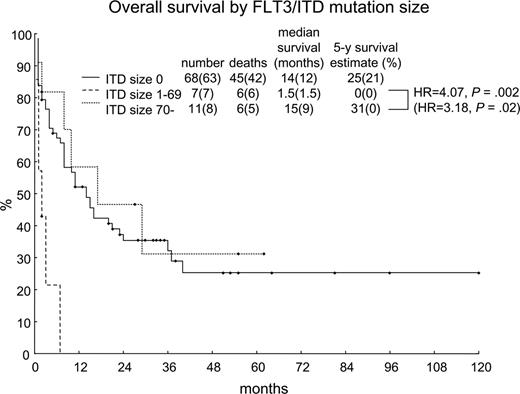We read with great interest the paper by Stirewalt et al1 analyzing the prognostic significance of different Fms-like tyrosine kinase (FLT3) gene internal tandem duplication (ITD) size in acute myeloid leukemia (AML). There is a considerable variability in ITD size, and Stirewalt et al1 suggest that with increasing size of ITD there is a more significant loss of autoinhibitory function of FLT3, translating into inferior prognosis. We would like to comment on this issue based on our results, which may suggest different conclusions.
We have analyzed 86 consecutive patients with AML, 37 men and 49 women, with a median age of 57 years (range, 18-85 years), by reverse transcriptase-polymerase chain reaction (RT-PCR) for FLT3/ITD mutation.2 We have found 18 (20.9%) patients with FLT3/ITD mutations, with the highest frequency (3/8; 37.5%) in acute promyelocytic leukemia (APL). ITD was associated with higher white blood cell (WBC) count (67 vs 26 × 109/L, P = .013) and somewhat inferior survival (hazard ratio [HR] = 1.98; confidence interval [CI] 1.11-6.11; P = .02, when we exclude patients with APL). There was no significant difference in age, sex, cytogenetic risk, and other hematologic parameters between FLT3/ITD-mutated and unmutated patients.
Median ITD size was 70 bp (range, 30-100 bp). ITD size was negatively correlated with age (R =-0.51; P < .05) and cytogenetic risk (R =-0.58; P < .05) and was not correlated with WBC count, sex, or other hematologic parameters. We have divided our patients' FLT3/ITD mutations into long (≥ 70 bp; 11/18, 61.1%) and short ITD (< 70 bp; 7/18, 38.9%) subgroups. We found better survival in the long-ITD subgroup (HR 4.07, CI 2.28-56.32; P = .002)3 (Figure 1), even without patients with APL (HR 3.18, CI 1.31-27.28; P = .02). In the multivariate Cox proportional hazard model, with ITD size as continuous variable, in overall series higher age, WBC count, and poor cytogenetic risk were associated with poor prognosis. However, in FLT3/ITD-mutated patients, only age and WBC count were associated with prognosis, but when we excluded patients with APL, ITD size also had independent prognostic significance (P = .05).
Overall survival by FLT3/ITD size for 86 patients with AML. Kaplan-Meier estimates are shown. Marks represent censored cases. Values in parentheses are results with patients with APL excluded.
Overall survival by FLT3/ITD size for 86 patients with AML. Kaplan-Meier estimates are shown. Marks represent censored cases. Values in parentheses are results with patients with APL excluded.
In our series of patients with AML, association with prognosis was opposite to that of Stirewalt et al.1 It is unlikely that different ITD amplification methods using cDNA2 versus DNA templates1 or different cutoff values (40 vs 70 bp) are critical. When we used the same cutoff (40 bp), in the short-ITD subgroup there were only 5 patients but the survival was still significantly shorter (P = .02). In our group, ITD size was negatively associated with age and cytogenetic risk—which is not observed by Stirewalt et al,1 although values for major parameters were quite similar. Also in our group with FLT3/ITD mutation there were 3 patients with APL, all with long ITDs, but the difference was still significant when we excluded patients with APL.
Quantitatively equal activating potential of both FLT3 mutation classes (ITD and tyrosine kinase domain) and activation of additional signaling pathways, including STAT5 pathway, by FLT3/ITD may suggest qualitative differences as the basis for different biologic effects of FLT3 mutations.4 Thus the observed different biologic effects of different FLT3/ITDs may relate to a different activation of these additional signaling pathways. FLT3 modeling and functional studies including signaling as well as further clinical studies are warranted to resolve these puzzling and conflicting results.
Does FLT3/ITD size matter?
In this issue of Blood, Kusec et al describe their results examining the potential prognostic significance of FMS-like tyrosine kinase 3/internal tandem duplication (FLT3/ITD) size in 86 patients with acute myeloid leukemia (AML). Contrary to our recent publication,1 these investigators found that patients with AML with smaller FLT3/ITDs had a worse prognosis. The exact reason for the disparity of the results between the 2 studies is uncertain. These investigators used a different screening technique, which may not be as sensitive as the method in our analyses (polymerase chain reaction/single-strand conformation polymorphism [PCR/SSCP]).2 Using a less sensitive screening method will reduce the detection of the smallest ITDs, and if only the smallest ITDs are associated with favorable outcomes, the potential benefits of these small ITDs would be lost in their analyses. In addition, it was not clear from the analyses what type of therapy these patients received or if all patients received the same treatment. Differences in therapy between the 2 studies or within their study could have significant impact on their results and be responsible for some of the differences. For example, if patients receiving aggressive therapies such as transplantation were included in the analyses, these therapies must be examined as potential confounding variables. Although the findings are interesting and potentially informative, we believe that larger studies examining more patients remain necessary in order to either confirm or disprove that patients with AML with large FLT3/ITDs have an overall worse prognosis than similar patients with small FLT3/ITDs.
Correspondence: Derek L. Stirewalt, Fred Hutchison Cancer Research Center, D5-380, 1100 Fairview Ave North, Seattle, WA 98109; e-mail: dstirewa@fhcrc.org.


This feature is available to Subscribers Only
Sign In or Create an Account Close Modal